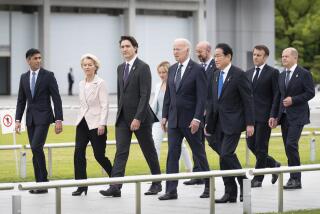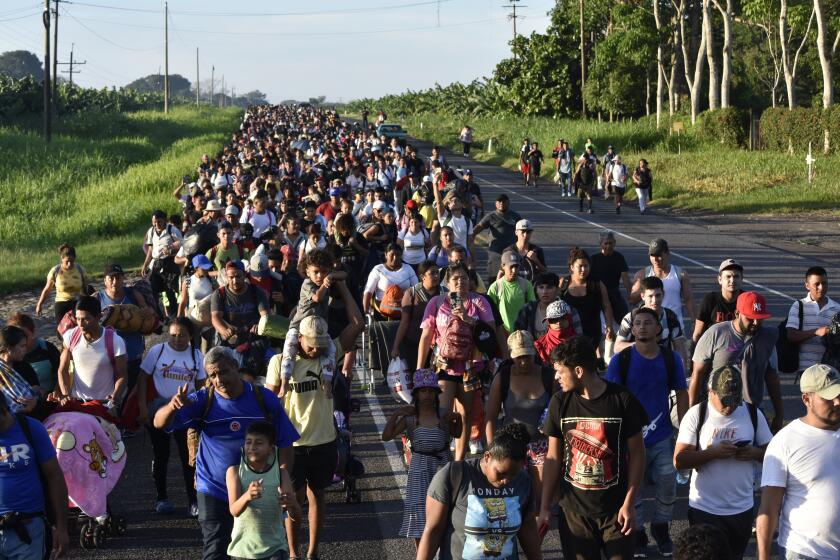Revolution on a Shoestring : Cuban Government Sees Downsizing as Way to Revitalize
Revolutionary hero Ernesto “Che” Guevara founded the Kaloney shoe factory three decades ago as an example of Cuban industry under dictator Fidel Castro. It was to be a plant where workers could make a decent living by making a simple, useful product.
This week, as Kaloney celebrated its 30th anniversary, the factory about an hour from Havana is still a showcase. But it has become a far different place than what Che envisioned.
Kaloney now is an example of downsizing, Cuban style. In the last five years, its labor force has gradually been cut from 1,200 workers to 550 and its production methods and organization have changed completely.
For most of its history, Kaloney turned out 7,000 pairs of identical, unfashionable work boots a day. Today the plant is divided into nine factories--two with foreign partners--and produces half as many shoes in dozens of different styles.
Only one of the factories--the smallest, with 17 workers--makes shoes for the peso market, and those are cheap plastic sandals. The rest are exported or sold in Cuban stores that price merchandise in dollars, to pay for the imported leather, glue and thread used to make them.
The factory that once kept a $7,500 inventory now prides itself on having practically just-in-time delivery.
Indeed, last year Kaloney recorded profit of about $60,000 (at current exchange rates) on sales of about $550,000, said general manager Oneida Calzada, a sinewy woman with close-cropped salt-and-pepper curls.
Wages have also increased; the average rose nearly 40%, from about $7 a month to about $9.75 over the five years since downsizing began. Workers can triple their pay with night and weekend piecework. And they get bonuses based on profit--about $7.35 each last June and, when profit slipped, about $4 in December.
The 48-year-old Calzada--whose name, appropriately enough, means footwear--was one of the factory’s original workers, starting her career on the assembly line. She has seen plenty of change.
*
But profit and bonuses notwithstanding, Calzada insisted that factories such as Kaloney still maintain the ideals of the revolution: “We started out with social improvements for the workers, and we still maintain those social improvements.”
She is proud that Kaloney has never halted production or closed the company cafeteria.
“We know that in 1993 [the worst year of Cuba’s economic crisis] the lunch we served at the factory was the only meal many workers ate,” she said.
In a country where manufacturing has been done by huge government-owned factories for decades, downsizing is the beginning of small industry, observers predict. The idea is to revitalize industries that can generate foreign currency and have a multiplier effect on the rest of the economy, experts said.
“Cuba is going to have small companies,” Cuban economist Omar Everleny Perez said. “On one hand, the huge government enterprises are shrinking. . . . on the other, family businesses [the only private enterprise currently permitted in Cuba] are growing.”
The two trends will eventually meet, he said, creating a small-business sector that will be a mixture of government and privately owned companies.
The shoe industry was the pilot project in Cuba’s version of downsizing. Next in line: textiles and clothing.
Without the subsidies it received from the former Soviet Union, Cuba could not afford to buy raw materials, which left industry here working at 20% to 25% of capacity. Many huge factories were mothballed and workers given generous unemployment benefits. To get factories working again--and to keep them open--the government is breaking them into smaller units that use less raw material.
Smaller factories have also had more success in attracting much-needed foreign investment because potential partners can put up a more modest stake.
However, most foreign investment is still in the form of joint production contracts, with the foreign partner providing raw materials and often some equipment, while the Cubans offer a site, workers and other equipment for a limited period.
At Kaloney, for example, Chilean investors provided manufacturing equipment for a joint venture to make children’s tennis shoes under the brand name Caguama (turtle). Spanish investors contributed raw materials and marketing know-how to start a sandal export business in another corner of the Kaloney factory.
Still, the transition is difficult, costing workers job security and changing relationships with their employers--in Cuba’s case, the government. Downsized factories offer fewer jobs. As a result, some people who have jobs will lose them and workers who are laid off may find they are permanently unemployed.
“The downsizing of Cuban industry is being done in a gradual, well-thought-out way,” said Havana economist Viviana Togores. “A lot of thought is being given to the possible social effects because workers are going to be put out on the street unemployed.”
*
In the Kaloney downsizing, the job cuts were relatively painless because the factory had a 30% turnover rate after each of the two semiannual vacations. The work force was reduced by attrition, and what was left was a more stable group of employees.
“We did not put a single person out of a job,” Calzada said proudly.
But in other industries, economists warn, downsizing is leaving thousands of workers jobless. The official count is 100,000 jobs eliminated over the last two years. Nongovernment economists project the figure could reach five to 10 times that as downsizing continues.
Those jobless already have contributed to an unemployment rate that the government puts at 7%. Private economists estimate the figure is closer to 20%.
But at plants such as Kaloney, workers still have hopes of bettering themselves.
Like Calzada, Caridad Carrillo started out as an assembly line worker. She took high school courses after work, in a classroom set up in the factory. Seventeen years later, at age 33--the average for Kaloney employees--she supervises the largest area, the boot line, with 95 workers.
“It used to be people just wandered around the factory, talking to their friends and flirting,” she said. “Now everyone is in their own area, where they belong. Everyone is busy.”
(BEGIN TEXT OF INFOBOX / INFOGRAPHIC)
Economic Shift
In an effort to make up for the loss of massive amounts of aid from the former Soviet bloc, the Cuban government is shrinking its own enterprises and allowing family businesses to grow. A look at the Cuban economy:
* Population: 10.9 million
* Gross domestic product: $14 billion
* Major industries: sugar milling and refining, petroleum refining, food and tobacco processing, textiles, chemicals, paper and wood products, metals
* Imports: $1.7 billion (major imports: petroleum, food, machinery)
* Exports: $1.6 billion (major exports: sugar, nickel, shellfish, tobacco, medical products, citrus, coffee)
Note: All figures are for 1994, except for population, which is for 1995.
Source: Central Intelligence Agency
More to Read
Sign up for Essential California
The most important California stories and recommendations in your inbox every morning.
You may occasionally receive promotional content from the Los Angeles Times.






